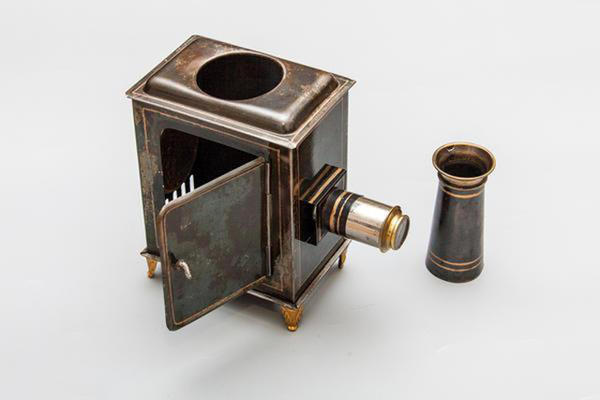The cinema was a shared entertainment for the Imperial family, especially for young Tsarevich Alexei. Nicholas II had a projection hall installed in the Alexander Palace. It was equipped with a screen and a projector. The young prince acted as a projectionist and operated the projector himself during every show.
In 1912, Alexander Khanzhonkov, a pioneering Russian film director, sent the royal family ‘a chest box with three films made at our factory’, i.e. made by his film studio: Dragonfly and Ant and Christmas of the Forest Inhabitants, two animated films, and Shelter Ship Tsesarevich Alexei, a newsreel about a training ship for destitute and orphaned boys. Shortly before the revolution, the French film studio Pathé sent the heir to the Russian throne a present — a small film camera with many animated film reels.
After the revolution, the Romanovs were exiled to Tobolosk. Among the things they received from the Alexander Palace there was a motion-picture camera, twenty-one boxed film reels, a screen and a magic lantern, a device that projected painted images from glass slides.
It is not known for sure who invented the magic lantern. The first similar projection equipment appeared back in the 16th century. The design practically did not change during several centuries. The apparatus had a wooden or metal case with a hole and a lens, and a source of light inside: initially, it was an oil lamp or a candle; later, with the invention of electricity, it was replaced by a light bulb.
The images were painted or printed on glass sheets held within a cardboard or wooden frame and were projected through the hole and the lens onto the screen. Sometimes the light from the candle or the oil lamp inside the box was amplified by a lens. Later, a reflector (a concave mirror) was used to produce a brighter image.
Magic lantern images were often projected in large venues — at fairs, exhibitions, variety theaters and other public places. The subjects of lantern slide shows could vary from a humorous story and an educational lecture to a narrative sequence of historical events. Projections of magic lantern slides were often used to illustrate and enhance live performances by reciters and musicians. Originally, the images were painted on glass slides but with the invention of photography printed images gradually replaced painted images. The Magic Lantern was a prototype and forerunner of modern devices for projecting images such as a slide projector, epidiascope, and photographic enlarger.
In 1912, Alexander Khanzhonkov, a pioneering Russian film director, sent the royal family ‘a chest box with three films made at our factory’, i.e. made by his film studio: Dragonfly and Ant and Christmas of the Forest Inhabitants, two animated films, and Shelter Ship Tsesarevich Alexei, a newsreel about a training ship for destitute and orphaned boys. Shortly before the revolution, the French film studio Pathé sent the heir to the Russian throne a present — a small film camera with many animated film reels.
After the revolution, the Romanovs were exiled to Tobolosk. Among the things they received from the Alexander Palace there was a motion-picture camera, twenty-one boxed film reels, a screen and a magic lantern, a device that projected painted images from glass slides.
It is not known for sure who invented the magic lantern. The first similar projection equipment appeared back in the 16th century. The design practically did not change during several centuries. The apparatus had a wooden or metal case with a hole and a lens, and a source of light inside: initially, it was an oil lamp or a candle; later, with the invention of electricity, it was replaced by a light bulb.
The images were painted or printed on glass sheets held within a cardboard or wooden frame and were projected through the hole and the lens onto the screen. Sometimes the light from the candle or the oil lamp inside the box was amplified by a lens. Later, a reflector (a concave mirror) was used to produce a brighter image.
Magic lantern images were often projected in large venues — at fairs, exhibitions, variety theaters and other public places. The subjects of lantern slide shows could vary from a humorous story and an educational lecture to a narrative sequence of historical events. Projections of magic lantern slides were often used to illustrate and enhance live performances by reciters and musicians. Originally, the images were painted on glass slides but with the invention of photography printed images gradually replaced painted images. The Magic Lantern was a prototype and forerunner of modern devices for projecting images such as a slide projector, epidiascope, and photographic enlarger.



